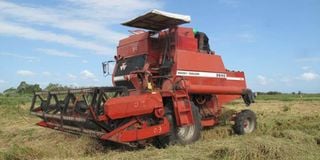How regional bodies can spur the nation’s progress

A combine harvester is used to harvest rice at a Tarda farm in Gamba, Garsen, Tana River County.
What you need to know:
- In Kenya, regional development authorities were established to spur regional socioeconomic development.
- They were further mandated to plan, develop, implement and coordinate integrated basin-based programmes and projects.
In East Africa, regional development challenges have become increasingly constraining, thereby substantively increasing the region’s susceptibility to negative shocks, with the most recent one being the prevailing Covid-19 pandemic.
Alleviating these threats, therefore, and achieving timely and sustainable progress across the region will require investment buy-ins by all players founded on a strategy underpinning better integration, cooperation and collaboration.
In Kenya, regional development authorities were established with the specific mandate of spurring regional socioeconomic development through sustainable utilisation of natural resources. They were further mandated to plan, develop, implement and coordinate integrated basin-based programmes and projects.
The criterion for establishing and delineating the bodies was based on river basins and large water bodies. The authorities were, therefore, not established on a political basis; neither do they comprise political or administrative boundaries.
The delineation was purely based on the area of influence of the water body, covering more than one administrative boundary. The Tana and Athi Rivers Development Authority (Tarda) covers more than 19 counties through which the Tana and Athi Rivers transect.
Strategic position
Its projects, including power generation and irrigation schemes for agricultural production, have had a direct impact on the local communities in as far as opening up the areas for infrastructure development and other supporting services and also employment creation are concerned. Regional planning plays the role of interpreting national goals into actionable and realisable projects.
The distinguishing factor between planning at the regional and local levels is that at the regional level there is more emphasis on projects aimed at the national public good rather than that of one locality. Much emphasis is also placed on equitable development of the entire region, ensuring balanced development, especially of infrastructure.
The authorities are critical due to their strategic position of analysing the issues of regional imbalance and spatial distribution of resources within the wider region. Regional imbalances can be addressed by ensuring equitable distribution of resources within their areas of jurisdiction.
This means that programmes implemented do not only target the benefit of one particular county but rather the entire river basin. Based on the river continuum, activities implemented along a section of a river in one county will have an impact on the others.
In the current unprecedented times that we are facing, resilience spurred by regional development bodies will foster the capability of systems and institutions to guide the region and indeed the Government to alleviate, adjust to and recover from shocks and pressures in a manner that ultimately reduces chronic vulnerability and subsequently facilitates inclusive growth at all levels.
Mr Roba is the managing director, Tana and Athi Rivers Development Authority (Tarda). [email protected]





